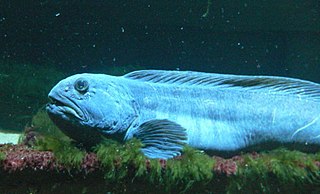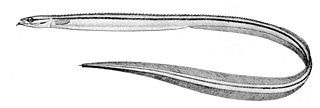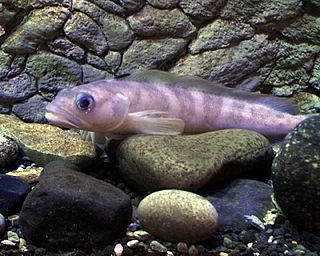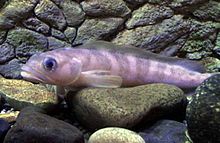
The Scorpaeniformes are a diverse order of ray-finned fish, including the lionfishes and sculpins, but have also been called the Scleroparei. It is one of the five largest orders of bony fishes by number of species, with over 1,320.

Anarhichadidae, the wolffishes, sea wolves or wolf eels, is a family of marine ray finned fishes belonging to the order Scorpaeniformes. These are predatory, eel shaped fishes which are native to the cold waters of the Arctic, North Pacific and North Atlantic Oceans.

Pholidae is a family of marine ray-finned fishes, known as gunnels, in the scorpaeniform suborder Zoarcoidei. These are fishes of the littoral zone and are mainly found in North Pacific Ocean, with two species found in the North Atlantic Ocean and Arctic Ocean.

Stichaeidae, the pricklebacks or shannies, are a family of marine ray-finned fishes in the suborder Zoarcoidei of the order Scorpaeniformes. Most species are found in the North Pacific Ocean with a few in the North Atlantic Ocean.

The quillfish,, is a species of marine ray-finned fish, it is the only species in the genus Ptilichthys and family Ptilichthyidae. This fish occurs in the northern North Pacific Ocean.

The stripedfin ronquil, also known as the bluebanded ronquil, is a species of marine ray-finned fish belonging to the family Bathymasteridae, the ronquils. This fish is found in the eastern Pacific Ocean.

Bathymaster signatus, the searcher, is species of marine ray-finned fish belonging to the family Bathymasteridae, the ronquils. This species is found in the northern Pacific Ocean.

The Trichodontidae, or sandfishes, are a small family of ray-finned fishes from the order Scorpaeniformes. The species in this family are found in the North Pacific Ocean.

Zoarcoidei is a suborder of marine ray-finned fishes belonging to the order Scorpaeniformes. The suborder includes the wolffishes, gunnels and eelpouts. The suborder includes about 400 species. These fishes predominantly found in the boreal seas of the northern hemisphere but they have colonised the southern hemisphere.

Zaniolepis, the combfishes, is a genus of marine ray-finned fish, it is one of two genera in the family Zaniolepididae. These fishes are native to the eastern Pacific Ocean. Z. frenata that was a source of food to the Native American inhabitants of San Nicolas Island off the coast of southern California, United States during the Middle Holocene.

Anarhichas is a genus of marine ray-finned fishes belonging to the family Anarhichadidae, the wolffishes or sea wolves. These fishes are found in the northern North Atlantic and North Pacific oceans.

The Zaniolepididae is a family of marine ray-finned fishes classified within the suborder Cottoidei of the order Scorpaeniformes. They are found in the North Pacific Ocean.

Cryptacanthodes is a genus of is a genus of marine ray-finned fishes belonging to the monogeneric family Cryptacanthodidae, commonly referred to as wrymouths. Three of the four species are found in the Pacific Ocean with one species native to the western Atlantic Ocean where they are benthic fishes, tunneling through soft substrates. It is currently the only known genus in its family.

Neosebastinae, the gurnard scorpionfishes or gurnard perches, is a small subfamily of deep-sea ray-finned fishes, it is part of the family Scorpaenidae. These fishes are found in the Indian and Pacific oceans. Several of the species in this family are venomous.

Bathymaster is a genus of marine ray-finned fishes belonging to the family Bathymasteridae, the ronquils. These fishes are found in the northern Pacific Ocean.

Rathbunella is a genus of marine ray-finned fishes belonging to the family Bathymasteridae, the ronquils. These fishes are found in the eastern Pacific Ocean.

The northern ronquil is species of marine ray-finned fish belonging to the family Bathymasteridae, the ronquils. This species is found in the eastern Pacific Ocean. This species is the only known member of its genus.
Eulophiidae, the spinous eelpouts, is a small family of marine ray-finned fishes classified within the suborder Zoarcoidei of the order Scorpaeniformes. They are found in the northwestern Pacific Ocean.

Opisthocentrinae is a subfamily of marine ray-finned fishes, classified within the family Stichaeidae, the pricklebacks or shannies. These fishes are found in the North Pacific Ocean.
Gymnelinae is a subfamily of marine ray-finned fish belonging to the family Zoarcidae, the eelpouts. Most species are found in the North Pacific Ocean but one genus is cosmopolitan, and another is endemic to the Southern Ocean.















